27 Ingredient Swaps That Will Make Store-Bought Pancake Mix So Much Better
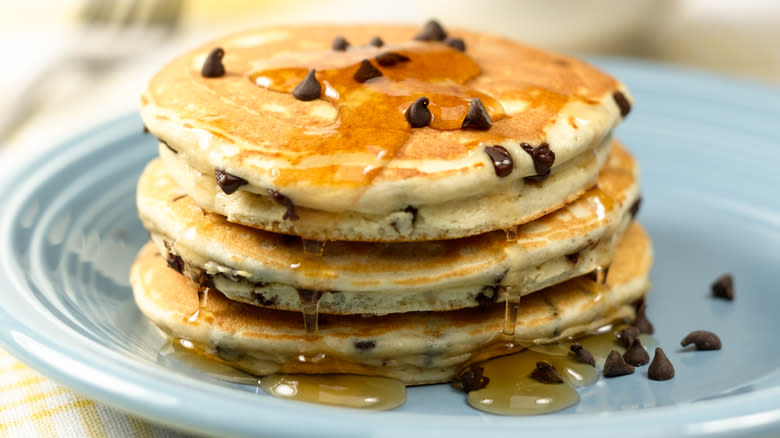
Whether you call them crepes, injera, dosa, msemen, or blini, pancakes are a staple of the human diet. Archaeological evidence discovered in Iraq's Shanidar Cave complex indicates humans were cooking something akin to a proto-pancake 70,000 years ago. The first ready-mix pancake flour was not introduced until 1889, however, by Chris L. Rutt and Charles G. Underwood, owners of the Pearl Milling Company. This revolutionized pancakes forever. Whether you make your own homemade pancake mix or purchase it pre-made, its ease and convenience can't be beat.
That said, these mixes can be bland. I know this better than most: Over the course of 18 years as the chef and owner of a bed and breakfast, I made thousands of pancakes. I know the secrets to transforming pitiful pancakes into heavenly hotcakes. While unexpected ingredients can improve pancakes (and make them more fanciful), I'm here to suggest some simple swaps for the primary ingredients often added to store-bought pancake mix. These substitutions for water, milk, eggs, and oil can accommodate various dietary restrictions, and transform the flavor and texture of the batter itself, making a pre-made mix so much better. Get your griddle ready -- it's time for the best breakfast you've ever had.
Read more: 14 Liquids To Add To Scrambled Eggs (And What They Do)
Buttermilk
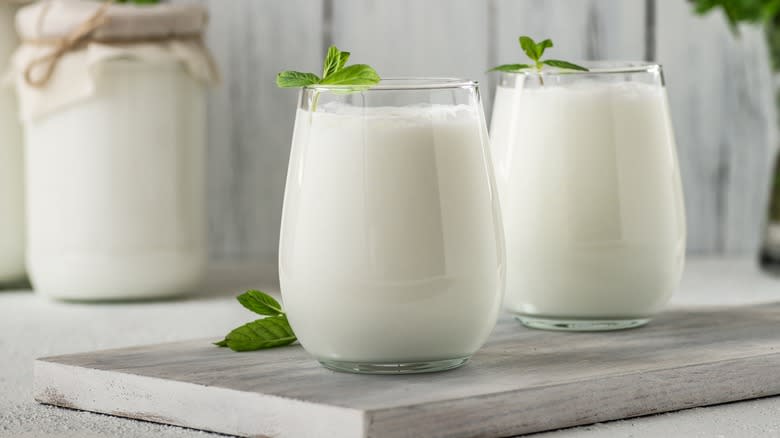
A majority of store-bought pancake mixes require the addition of water or milk to form the batter. Try swapping those routine liquids with equal quantities of buttermilk to create flapjacks with a richer flavor and fluffier texture. Buttermilk is, historically, a by-product of the process of making butter. Back in the day, the leftover liquid was allowed to ferment overnight, naturally congealing it. This fermentation process is now produced by adding live cultures, but its uses in baking remain the same.
The resulting acidity helps confer a tangy taste, reacts with baking soda to leaven pancakes, and dismantles gluten proteins in the flour. This results in tender, tasty pancakes. Take note: You can make homemade buttermilk by adding one tablespoon of lemon juice or vinegar to a cup of milk or heavy cream. Let it stand for 10 minutes before adding it to your pancake mix.
Sparkling Water Or Seltzer

Sparkling water or seltzer is a good alternative to water or milk in store-bought pancake mix. The carbonation elevates pancakes by incorporating bubbles into the batter, making them extra light and fluffy. Additionally, the process of carbonating water increases its acidity. This breaks down gluten, making the pancakes softer and fluffier.
Consider using a flavored carbonated beverage in your pancakes to get extra snazzy. There's a seemingly endless variety of fizzy water out there, some with quirky flavors like orange vanilla or ginger strawberry. These distinctive tastes can deliver subtle and delicious notes. Said notes can also be fun to complement: Orange blossom water and vanilla extract would bolster pancakes made with citrus-flavored seltzer, for example.
Lemon-Lime Soda
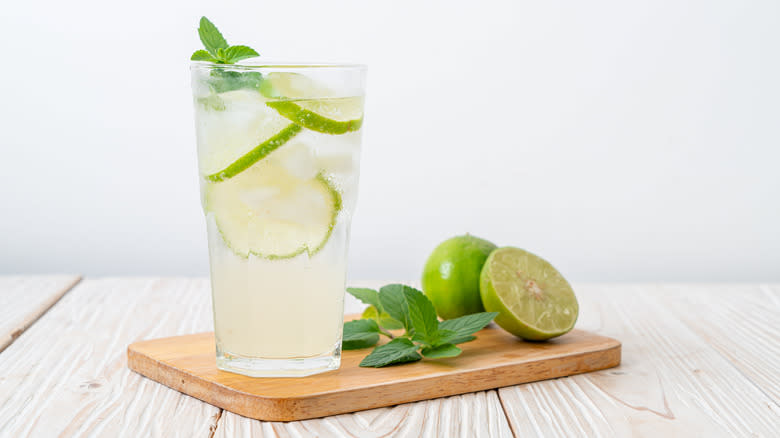
Using lemon-lime soda in baking is hardly novel. During World War II, rationing inspired creative cooks to replace baking soda in cakes with the fizzy drink. Like sparkling water, the carbonation in lemon-lime soda has a marvelous capacity to aerate cake batter, delivering a tall, puffy result.
It's no less useful when experimenting with store-bought pancake mix. The soda will add carbonation, and the higher acidity impacts texture and color. Because there is leavener in store-bought pancake mix, the soda lightens the flapjacks twice over, once with carbonation and again by reacting with the baking soda. This results in delightfully golden hotcakes with a shiny crust that resist burning. Toss some fresh blueberries and lemon zest into the batter to accentuate the pancakes' citrusy flavor.
Ricotta Cheese
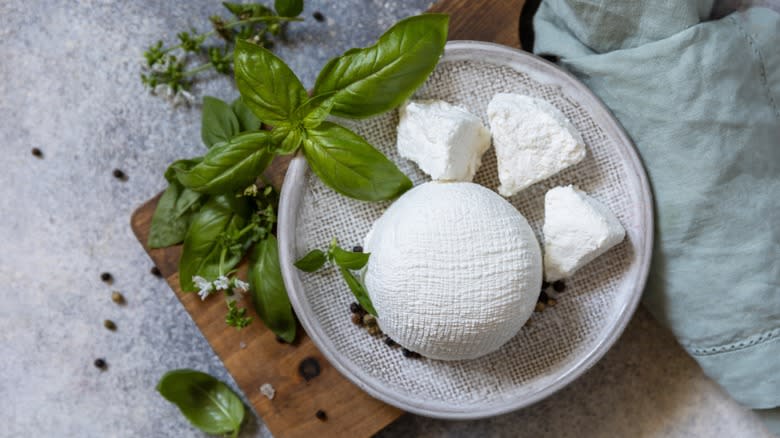
Ricotta cheese is an Italian specialty made by recooking the whey left behind by the cheesemaking process. The result is a velvety, rich, delicate cheese that is slightly sweet and granular. Its American counterpart incorporates milk for creaminess. It can be used in pancakes instead of milk or water, but not in equal ratios. You'll generally require slightly more ricotta to help moisten a store-bought pancake mix adequately, without making it too dense.
Depending upon the mix, using ricotta may take a bit of trial and error -- but the results are worth it. Pancakes made with full-fat ricotta develop a fluffy yet moist richness that almost resembles a custard more than the chewy breadiness of a classic pancake. The higher fat ratio keeps the center luscious, and the mild cheesy flavor lends itself to several toppings, including lemon curd and raspberry preserves.
Cottage Cheese
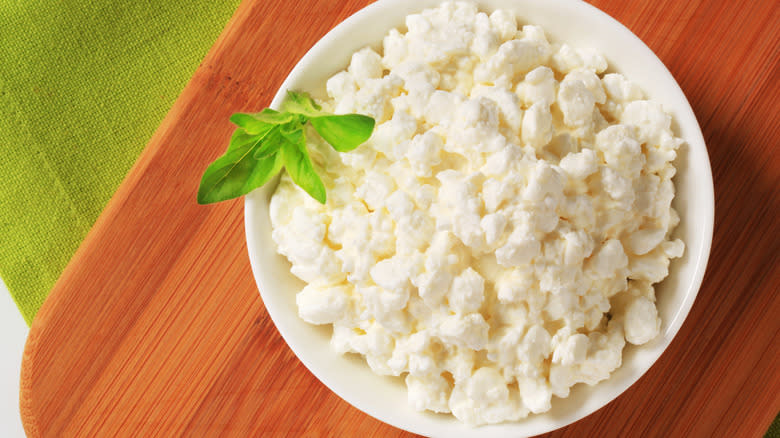
What exactly is cottage cheese? Cottage cheese is a versatile dairy produce created by infusing milk with acid or live bacterial cultures, forcing the whey to separate from the curds. These curds are removed and combined with salt. The result is a tangy, creamy cheese that comes in various sized curds. It is saltier than ricotta, higher in protein, and lower in fat.
When using it with store-bought pancake mix, opt for a small curd, higher fat cottage cheese for the best results. As with ricotta, test your batter to ensure it is pourable. If it's not, try balancing the cottage cheese with water or milk to get the correct moisture level without yielding too dense a batter. If you do it right, you should end up with fluffy, tasty, lusciously creamy pancakes.
Sour Cream
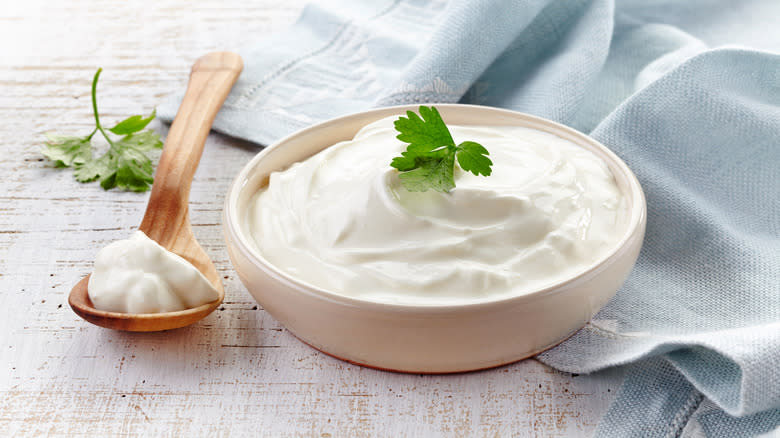
It is no secret that tangy sour cream can liven up a boxed cake mix. This fermented cream is altered by the addition of lactic acid bacteria. This results in a thick, rich product with a delightful sour flavor that can massively benefit baked goods, including store-bought pancake mix.
First, sour cream's added fat helps create a moist pancake without diluting the batter. Second, its acidity leavens the baking soda while tenderizing the cake by breaking down the protein strands within the flour. Third, the acidity also inhibits the pancakes from browning too rapidly. All of this means delicious pancakes. Just be sure to use full-fat sour cream and swap roughly 1/3 to 1/2 the amount of water or milk the pancake recipe calls for.
Greek Yogurt Or Kefir
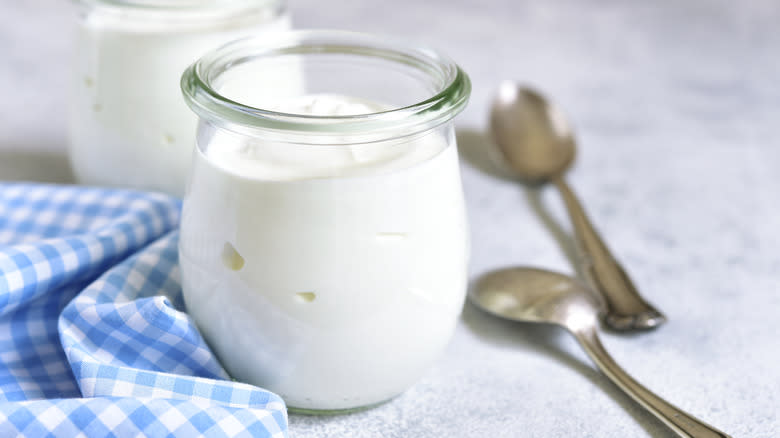
Greek yogurt and kefir are produced using live bacterial cultures, which transform lactose into lactic acid, thereby fermenting it. When some or all of the water or milk in a boxed pancake mix is replaced with either full-fat Greek yogurt or kefir, the resulting pancakes become fluffier and lighter. They also gain a pleasantly sour tang that pairs wonderfully with the sweetness of maple syrup, or your choice of sugary topping.
Because kefir is thinner than Greek yogurt, it can be more easily swapped one-to-one with water or milk. The luxurious texture of Greek yogurt, in contrast, may require some diluting with water. While it may seem tempting, I recommend against using flavored kefir or yogurt. The added sugar found in such products can transform the texture of the pancakes and cause them to burn more rapidly.
Orange Juice
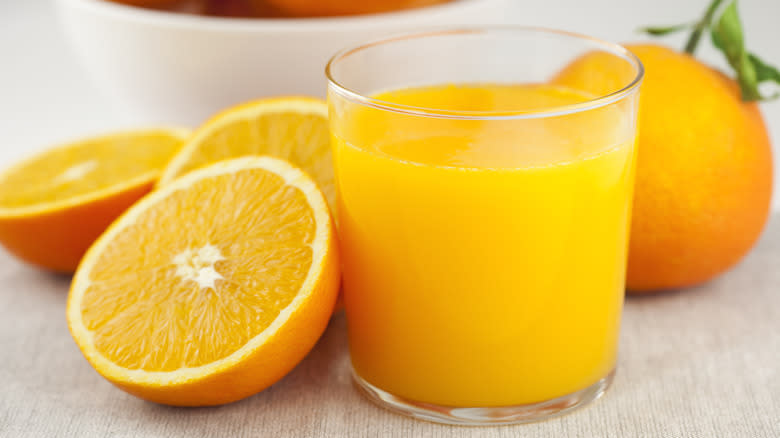
Like other acidic liquids, orange juice can be an ideal swap for milk or water in a store-bought pancake mix. Not only does it confer a delightfully citrus-forward aroma and flavor, the acidity leads to pillowy, golden brown flapjacks.
While fresh is always best, there's no reason not to use bottled or even frozen orange juice in your pancake mix. Remember, though, that store-bought orange juice often has sugar added, which can cause pancakes to brown slightly more rapidly. Additionally, frozen juice will need to be diluted with water before use. I always prefer pulpy orange juice because I enjoy the texture, but this is optional. Start by substituting half of the water or milk with the juice and work your way up, based on how assertive you want the orange flavor to be.
Oat Milk
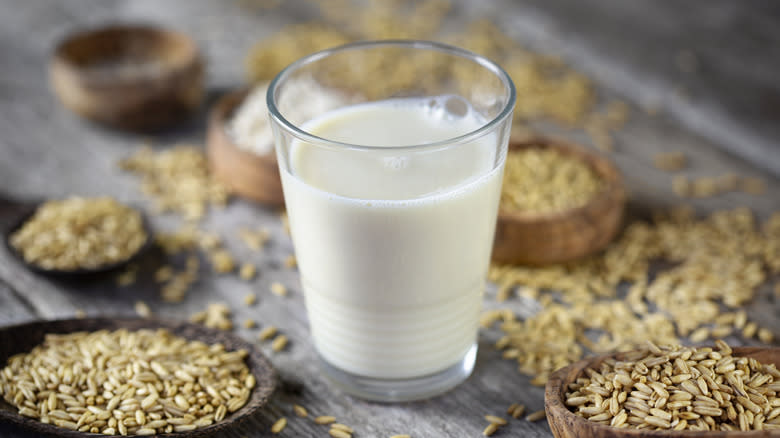
There are many reasons you may want (or need) to use a plant-based milk option in your pancakes. You might have a dairy allergy, or you could be looking for a flavorful alternative that is more environmentally friendly than dairy milk. If you're in this situation, you should know that oat milk is your best bet.
From an environmental perspective, oat milk leads over most other plant-based options and dairy milk in terms of its overall impact. From a taste perspective, its slightly sweet, nutty flavor and viscosity make it an ideal swap. When choosing oat milk for pancakes, make sure to search for unsweetened options and those not laden with emulsifiers, like gums or oil. Also, before use, shake the oat milk vigorously to ensure it's not separated. Proceed to use oat milk exactly as you would in your pancake batter, and be pleased by the tasty, tender results.
Coconut Milk
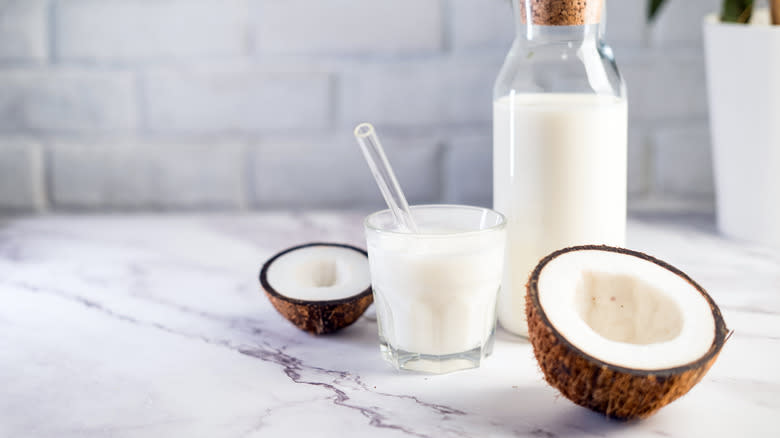
Coconut milk is another ideal substitute for water or dairy milk in store-bought pancake mix. Coconut milk tends to have a much bolder, fruity taste than other plant-based milks. It also has a much higher fat content, which can directly impact the moistness and richness of your pancakes. Coconut milk gives them a luxurious, nuanced mouthfeel, and the added fat makes the pancakes crisper.
Though you could use boxed or canned coconut milk, the texture of canned coconut milk tends to be thicker, which more fully resembles whole milk. It also typically contains only coconut milk, water, and guar gum. Boxed coconut milk often gets supplemented with added sugar, preservatives, and emulsifiers, giving it a more pourable texture, but making it a slightly chancier option when it comes to pancakes. Ultimately, the choice is yours. But whichever you use, make sure to stir or shake the coconut milk together before swapping it with water or milk in a one-to-one ratio.
Evaporated Milk
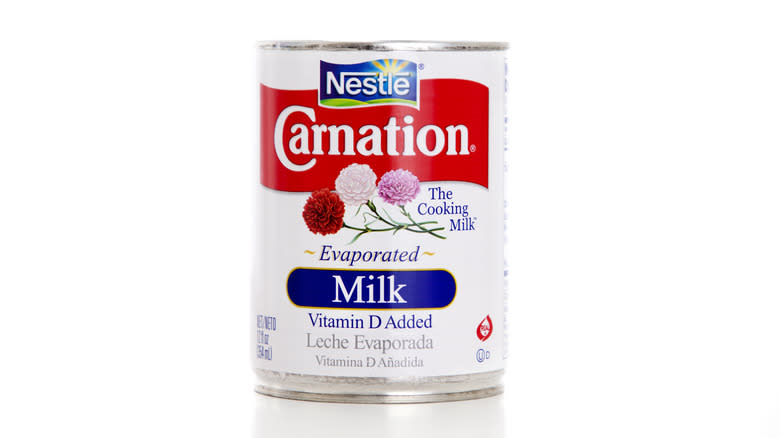
For the uninitiated, evaporated milk is created by heating cow's milk until roughly 60% of the water is reduced, leaving behind double the milk fat and solids. This shelf-stable canned alternative to whole milk can be delightful in store-bought pancake mix. Its viscosity gives the pancakes a richer texture, and its higher fat content enhances their moistness.
As a bonus, evaporated milk also has a slightly savory, nutty flavor that emerges as the dairy is lightly heated. This contributes to a complexity that just cannot be matched with plain whole milk. Though you can purchase fat-free evaporated milk, this really isn't the place to skimp on fat. Always buy full-fat evaporated milk and shake the can well before adding it to your pancakes in a one-to-one ratio to water or milk.
Egg Whites
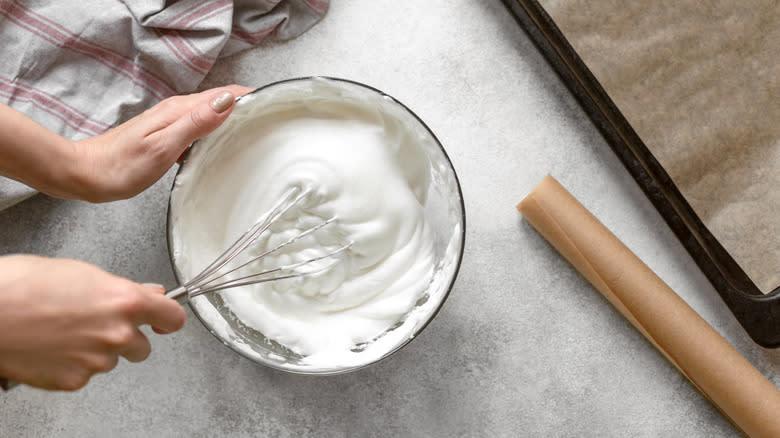
Some store-bought pancake mixes require you to add an egg or two to the batter. Rather than whisking the whole eggs, consider separating the whites from the yolks and whipping the former up first. Add a pinch of cream of tartar or lemon juice before beating the egg whites to stiff peaks. Once this is done, you can gently fold the whites into the prepared batter, taking care not to over-mix it, which can cause the resulting pancakes to become dense.
Adding egg whites to the batter helps the pancakes puff up, like a soufflé. Generally, you will need one egg white per cup of flour, though you can add more if you prefer a more cloud-like flapjack. If your store-bought pancake mix does not require adding eggs, you can still use this technique -- it won't hurt anything, and will still produce fluffy hotcakes.
Flax Meal
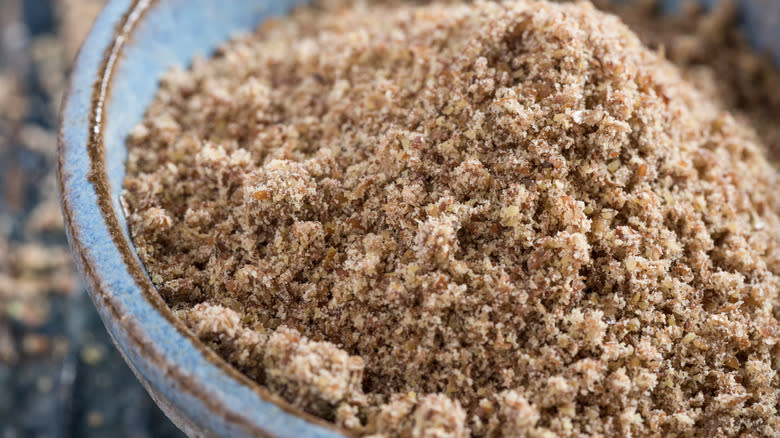
Flax meal, the ground iteration of flaxseeds, is added to various recipes to bolster fiber intake. Flaxseeds are available in two types: golden and brown. While they taste similar, golden flaxseeds are somewhat more subtle than brown ones, with a slightly nutty aftertaste that works well in baked goods, including pancakes.
When one tablespoon of flax meal is combined with three tablespoons of hot water, it forms a slurry that is an ideal facsimile of a chicken egg. The gelatinous texture of this "flax egg" acts like a binder, helping to thicken your pancakes the way a real egg would. This is a marvelous substitute for anyone with an egg allergy, a vegan diet, or those wanting to infuse their hotcakes with added fiber and omega-3 fatty acids. A flax egg may also help your pancakes keep you feeling fuller for a longer amount of time.
Mashed Banana
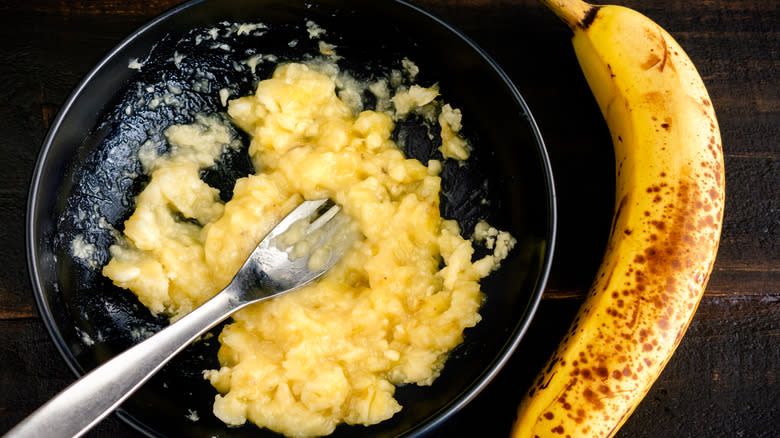
Mashed bananas are a natural choice when it comes to upgrading store-bought pancake mix. They are rich in nutrients, particularly fiber and potassium, and have an inherent sweetness that gives pancakes a delightful flavor. Bananas are also a secret weapon when you're looking to substitute eggs or oil, whether you're seeking a plant-based alternative, trying to cut back on fat, or something else entirely.
While they do not have the protein of eggs, mashed bananas bind your batter and provide the moisture conferred by oil. An average-sized banana is generally the equivalent of two eggs, but this may vary depending on the fruit. When substituting for oil, you can do so in a one-to-one ratio; you can always add more if your batter does not feel moist enough. Just be sure to mash the banana thoroughly before adding it so it is smooth and can be fully incorporated into the batter.
Applesauce
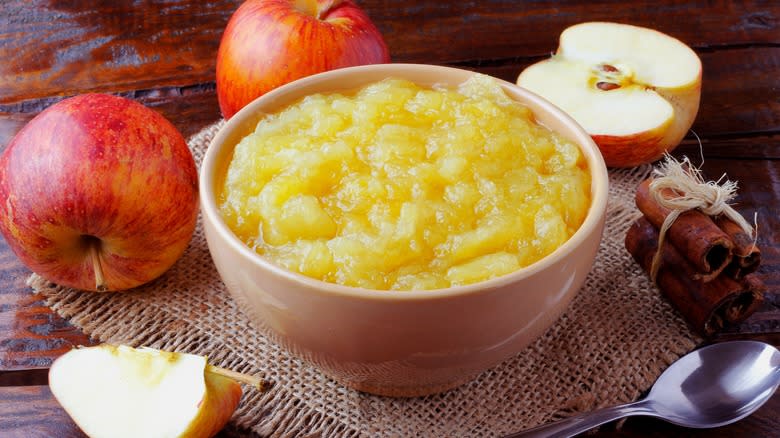
Like bananas, fiber-rich applesauce is an ideal substitute for eggs or oil in pancake mix. It acts as a binder and infuses the mix with moisture and homey apple flavor. If you're worried about the lack of egg, don't be -- unlike some recipes where eggs are used as a leavener, store-bought pancake mix already has added leavening agents, allowing it to rise without an egg.
When swapping these ingredients, use 1/4 cup of applesauce per egg, or equal parts applesauce to oil. Use unsweetened applesauce rather than sweetened: The added sugar can influence the flavor of the pancakes, making them too saccharine. The inherent sweetness of the fruit is already sweet enough. Additionally, applesauce has less fat than eggs or oil. This means the pancakes will likely cook faster than usual, so keep an eye on them to prevent burning.
Silken Tofu
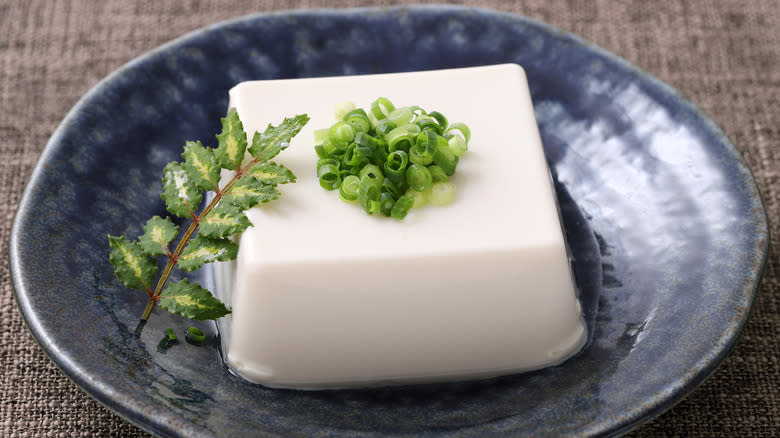
Tofu has long been a staple of many people's diets, especially in Asia. This protein-rich powerhouse is a chameleon in the kitchen. Its relatively neutral, slightly nutty flavor is pleasant, it adds moisture and acts as a binder in virtually any recipe, and it boasts a luscious texture. These attributes make it a great addition to pancake mix.
Tofu is available in several varieties, ranging from silken to extra firm. Silken tofu is what you want in this case; its high moisture content and uniquely creamy texture are ideal for pancakes. To use silken tofu instead of eggs in your batter, mash up 1/4 cup of tofu per egg needed. Soft tofu will work fine if you cannot locate silken tofu, but it may require more mashing to smoothly incorporate without overmixing the batter.
Sweetened Condensed Milk
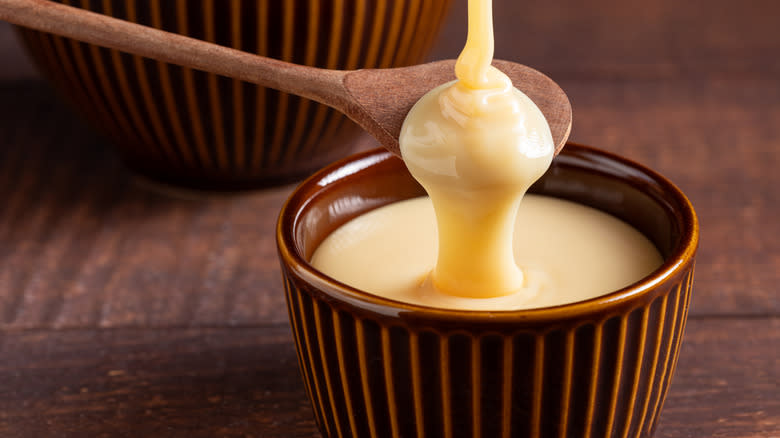
Sweetened condensed milk is a shelf-stable dairy product. It's made by reducing the moisture content of cow's milk by heating it under pressure until it has lost 50% of its water content. After this point, sugar is added, giving it its quintessential flavor, color, and viscosity. Using sweetened condensed milk in baking is not unusual, making it a natural fit as an egg substitute in store-bought pancake mix.
For every egg you wish to swap, use 1/4 cup of sweetened condensed milk. Compared with evaporated milk, which has roughly 10% sugar by weight, the sweetened condensed variety has 55%. This will directly impact the flavor of your pancakes, so adjust accordingly before drowning your pancakes in maple syrup. The lower fat content also causes the pancakes to cook faster, so exert caution to avoid burning them.
Cornstarch
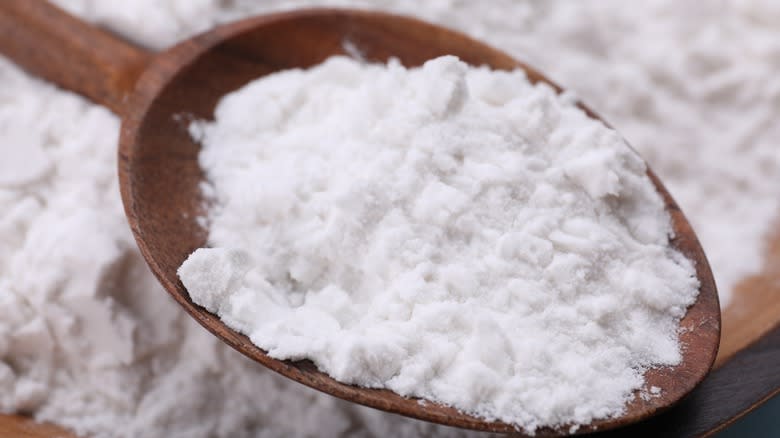
A cornstarch slurry can thicken a sauce, soup, or stew in mere seconds. But did you know that this magical stiffening power can also be used to mimic the binding capacity of an egg? Cornstarch is your friend if you're looking for a simple, plant-based egg replacement with a neutral flavor that can infuse much-needed moisture into your store-bought pancake mix.
The key is combining 1 tablespoon of cornstarch with 3 tablespoons of water. Whisk this together into a smooth paste before adding it to your pancake batter. Simply tossing cornstarch and water into your batter will not work: The cornstarch has to dissolve before it can develop its viscosity-producing talents. Also, avoid allowing the cornstarch to settle to the bottom of your slurry by using it immediately after whisking, rather than letting it sit.
Vinegar And Baking Soda
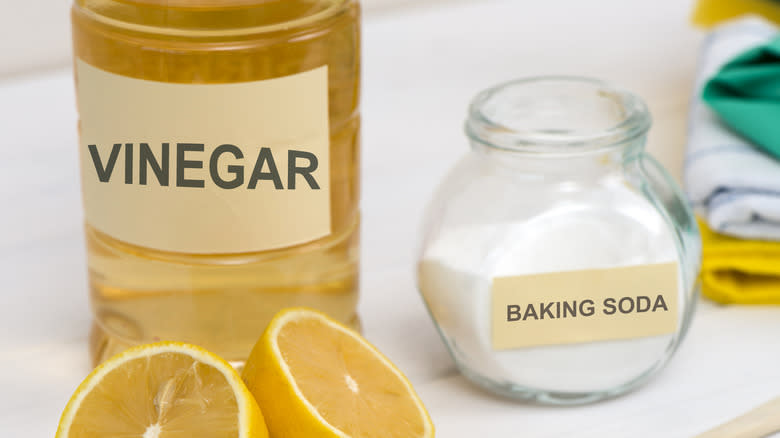
You have likely witnessed the awe-inspiring eruption that comes from combining vinegar and baking soda. This isn't reserved for science fair volcanoes, however -- this explosivity makes the dynamic duo a great alternative to eggs.
Just 1 teaspoon of baking soda and 1 tablespoon of apple cider vinegar per egg will suffice in a store-bought pancake mix. The mixture will instantly bubble up, leavening your pancakes and giving them an airy, light texture. This combination also infuses the pancakes with a hint of salinity that you probably won't detect underneath a dollop of maple syrup. If you do not have apple cider vinegar, I would recommend against using distilled vinegar. While the chemical reaction is the same, its flavor is somewhat harsh. Likewise, balsamic vinegar would not be a suitable substitute due to its taste and color.
Oil, Water, And Baking Powder
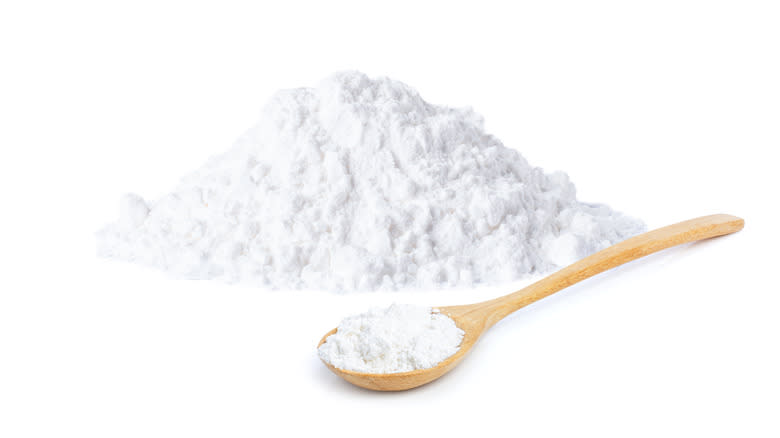
Yet another ideal swap for an egg in pancake mix is a combination of oil, water, and baking powder. This mixture involves 1 1/2 tablespoons of oil, 1 1/2 tablespoons of water, and 1 teaspoon of baking powder per egg. Before adding them to your batter, these ingredients should be whisked together in a separate bowl.
Be careful not to substitute baking soda for baking powder. While both are leaveners, they are not interchangeable. Baking powder is made from equal parts cornstarch, baking soda, and cream of tartar. This makes it less salty than pure baking soda. It also does not require an acid to be activated because it already has one added. When used properly, this mixture creates airy pancakes, keeps them moist, and gives them a chewy texture.
Aquafaba
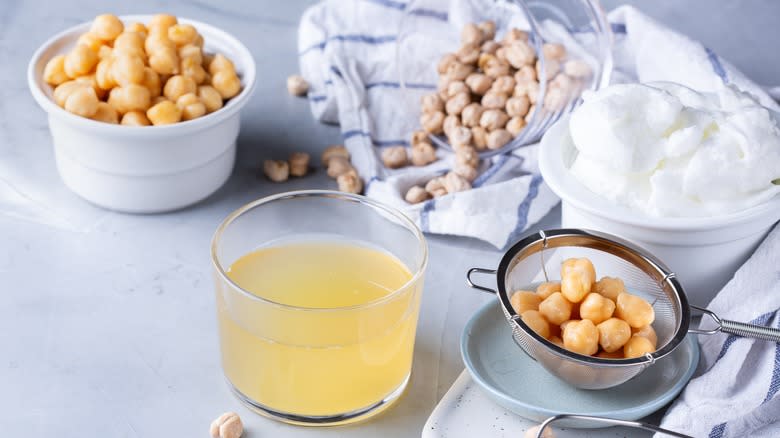
Don't get rid of the leftover liquid from your can of beans, especially if said can is full of chickpeas. This liquid, called aquafaba, is the egg substitute you never knew you needed, even if you're not vegan or don't have an allergy. As beans cook, water-soluble nutrients leach into the cooking water, yielding a viscous liquid capable of thickening and binding baked goods. In pancake mix, it acts as an egg does. If you're concerned about flavor, don't be: The taste is so faint, you won't detect anything overtly leguminous in your flapjacks.
All you need to substitute one egg is three tablespoons of aquafaba. If folding egg whites into your pancakes is your jam, you can even whip aquafaba with a pinch of cream of tartar to create a convincing facsimile. Do note, though, that it does take a bit longer to form stiff peaks.
Avocado
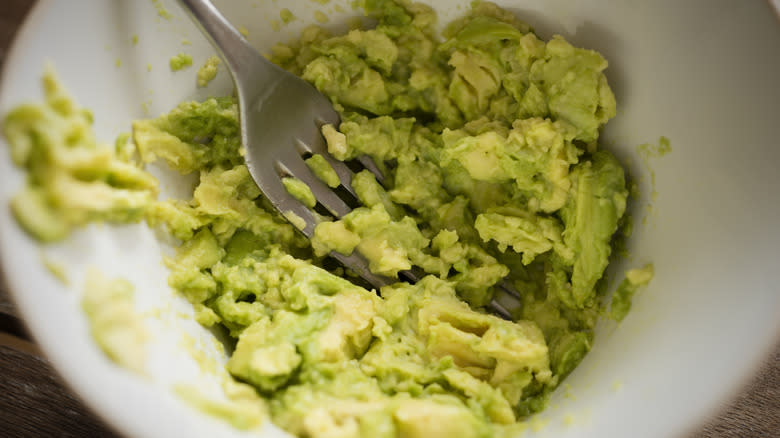
Sure, avocado toast is all the rage, but avocado pancakes? Yes, you read that correctly. Nutrient-dense avocados can be the perfect addition to store-bought pancake mix. Though they cannot be used for cooking your pancakes, they can be swapped in equal amounts for oil or melted butter. Just mash your avocado and whisk it into the mix
If your batter is still a little dry, add more liquid to loosen it before cooking up your pancakes. Because of the high fat content of avocados, you may notice your pancakes brown more rapidly. Just drop the temperature of your pan to keep from burning your flapjacks and you'll be fine. There won't be much difference in color or taste, but you will notice a creamy, luxurious mouthfeel. This is even more true if you use a whole wheat pancake mix and add other mix-ins.
Shortening
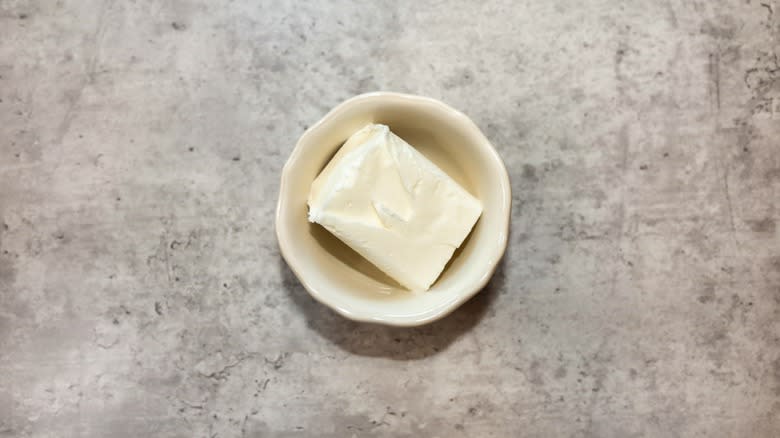
Shortening is an easy-to-use, shelf-stable, vegan fat, which makes it an excellent swap for oil or melted butter in pancake mix. Unlike butter, shortening contains no water, which results in no steam emission during baking. This can produce airier pancakes. It also has a higher melting point, which may encourage your pancakes to spread less when added to the pan.
When substituting shortening in a one-to-one ratio to butter, you may notice the pancakes have a slightly more crumbly texture. If you're concerned about this, you can always incorporate a tablespoon or two of water into the batter before cooking. Topping your flapjacks with syrup or adding fruit to the batter can also offset this. As a bonus, you can use shortening to cook your pancakes in the pan.
Coconut Oil
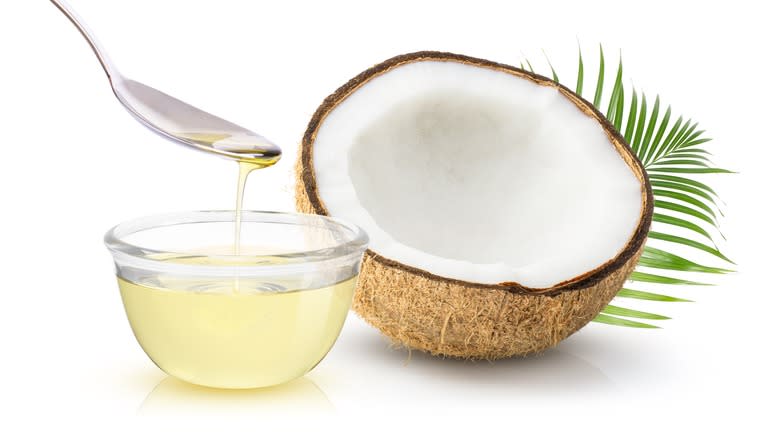
Much like shortening, coconut oil can easily be swapped for oil or melted butter in store-bought pancake mix. It lacks the excess water that butter contains, making baked goods pleasantly fluffy, though they can also become crisper. This can be mitigated by adding a tablespoon or two of water into the batter, or using liquefied coconut oil. You can purchase this specifically, or simply leave your coconut oil in a warm place, where it will readily melt.
Unlike shortening, coconut oil has a distinctive flavor that will be detectable in your pancakes. I find this delightful -- it brings a hint of nuttiness and a tropical vibe that is ideally paired with pineapple, mango, or banana. You might also consider cooking your pancakes in coconut oil. Coconut oil can tolerate higher heat than butter, producing delightfully golden brown pancakes without the risk of burning milk proteins.
Bacon Grease
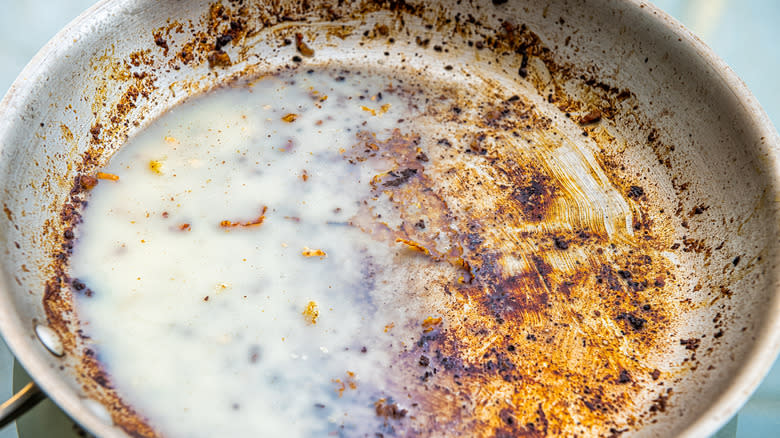
Bacon for breakfast is certainly not a novel idea. We often pair a short or tall stack of pancakes with this crispy, meaty delight. But you don't have to stick to plain old bacon and flapjacks when pairing these two breakfast staples. Using bacon grease to cook your pancakes instead of oil or butter transforms them into a sweet and salty delight that will have your tastebuds dancing with joy.
I recommend straining the hot grease to eliminate any residual impurities that could impact the overall mouthfeel of your flapjacks. I would also recommend against using maple-cured bacon, which can quickly burn if you aren't careful. Beyond that, go crazy.
Nut Butter
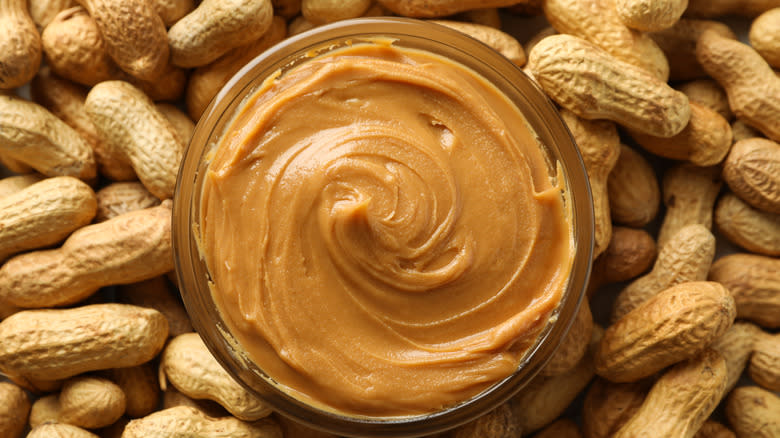
Nut or seed butter is a splendid and nutritious alternative to butter and oil in a store-bought pancake mix. It offers marvelous texture and notable flavor that can enhance your pancakes in delicious ways. The one caveat is texture. Because nut butter is relatively thick, you should soften it in the microwave or by using a double boiler before stirring it into your batter. Additionally, be extra cautious while cooking your pancakes, as they might brown more rapidly. I suggest lowering the cooking temperature to accommodate this.
Creamy or chunky nut butters both work in batter. I enjoy the chunks, but this may be distracting for other eaters. If you use natural nut butter, stir it well before measuring it out in a one-to-one ratio for oil or butter -- you want it to be as homogenous as possible.
Mayonnaise
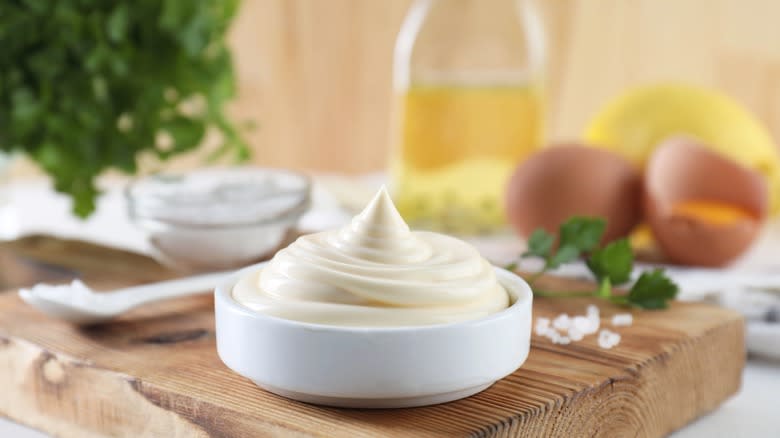
If you're searching for a one-size-fits-all substitute that can be swapped for both eggs and oil, consider a spoonful or two of full-fat mayonnaise. A spoonful of mayo can create the fluffiest pancakes you've ever eaten. Does this sound odd? Think again. Mayo is one of the secrets to the impossibly light Japanese-style pancakes millions have fallen in love with on social media. The condiment helps give them their quintessential soufflé-like texture.
The secret is in the vinegar contained within the mayonnaise. As the vinegar reacts with the baking soda in the mix, it instantly becomes activated, resulting in airy, cloud-like pancakes. The cakes will also benefit from the oil in the mayonnaise, which confers a richness to your flapjacks. And don't worry, the mayonnaise flavor will hardly be detectable in the finished pancakes -- especially once you top them with your favorite sweet syrup.
Read the original article on Daily Meal.

